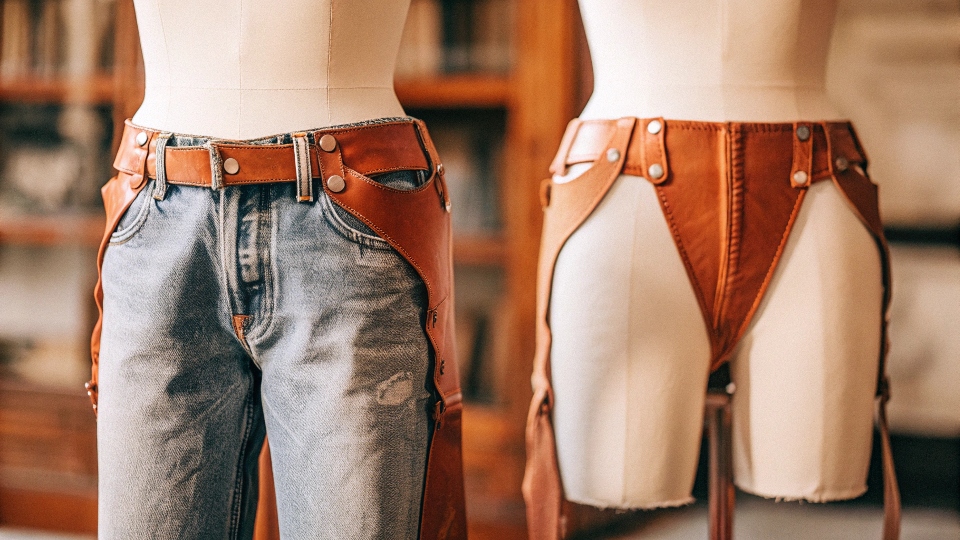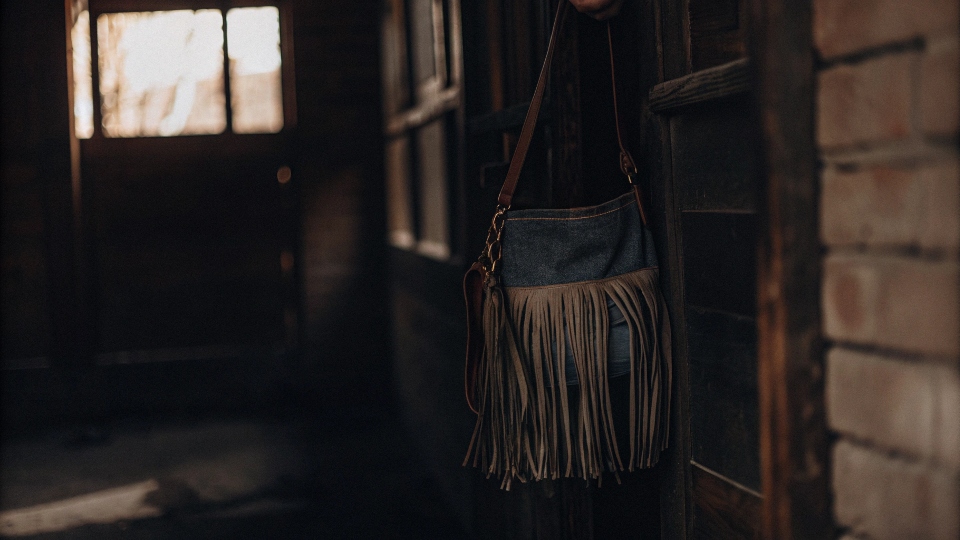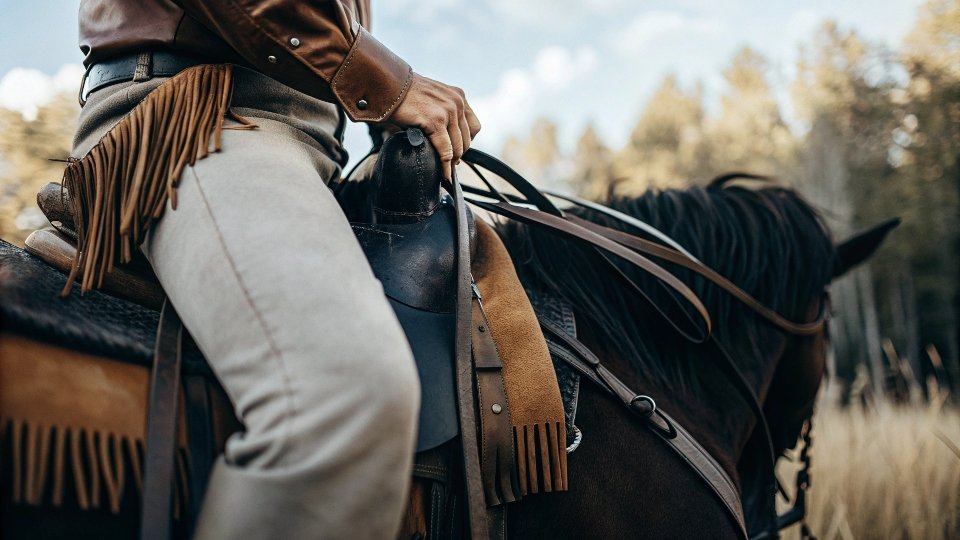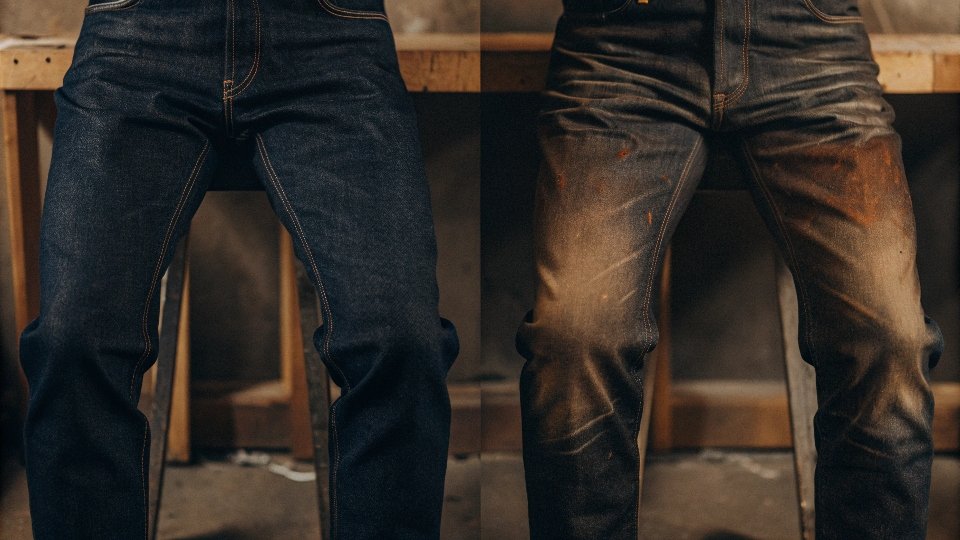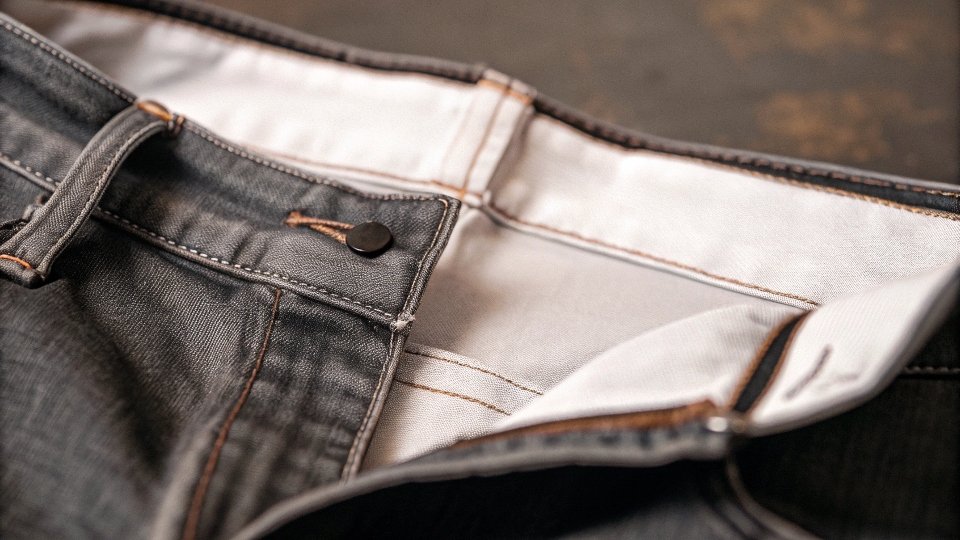You have a pair of old jeans and an itch for a bold, new style. You want to create something truly unique and head-turning, but the idea of working with leather or complex patterns seems daunting.
To make chaps from jeans, simply cut away the seat and crotch area. Leave the waistband and the full legs intact. The result is a pair of wearable chap-style leggings1 that connect at the waist for a secure fit.
For over 20 years, my passion has been denim. At my factory, DiZNEW, we handle this rugged fabric every day. I love seeing creative reinterpretations of classic garments, and turning jeans into chaps is a brilliant one.
Your insight on why chaps were invented is spot on—it’s about targeted protection without the bulk. Cowboys needed to protect their legs from the harsh environment, and denim provides a similar toughness.
This project takes that functional concept and turns it into a high-fashion statement. It’s easier than you think, and I'll guide you through it, along with some other great tips for giving your jeans new life.
How to make a bag out of jeans legs no sew?
You've made your awesome denim chaps, but now you're left with a bunch of fabric scraps. You hate waste and want a quick project for the leftover jean legs that doesn't require a needle.
Create an instant no-sew bag2 by cutting a jean leg to size, then making fringe at the bottom and tying it closed. Use another strip of denim for a shoulder strap, attached with simple knots.
This is one of my favorite upcycling tricks because it requires zero special tools and is incredibly fast. We often have off-cuts of denim at the factory, and this method is perfect for turning them into something useful instantly.
The key is in the knots. Lay the jean leg flat and decide on the depth of your bag. Cut it off. Then, at the open bottom edge, cut vertical strips about two inches deep and half an inch apart, creating a fringe.
Now, simply take the front and back pieces of fringe and tie them together in a tight double knot. Work your way all the way across the bottom. For the strap, cut a long, wide strip from the other jean leg and secure it to the top opening of your bag with knots. It's rustic, strong, and completely no-sew.
Why do cowboys wear chaps3 over jeans?
You see cowboys in movies or rodeos wearing chaps and wonder about the practicality. It looks like an extra, hot layer, making you question if it is more about style than actual function.
Cowboys wear chaps purely for protection. The thick leather shields their legs and their regular jeans from thorns, brush, rope burns, and even animal kicks. The open-seat design is critical for staying cool and flexible while spending long hours in the saddle.
Your insight hits the nail on the head. From my perspective as someone who understands fabrics, it’s all about a material serving its purpose. Denim is tough, but the work of a cowboy requires another level of durability. The chaps act as a rugged, removable outer shell. Think of them as specialized work armor.
Function Over Fashion
The primary job of chaps is to take a beating so the rider's legs and primary clothing don't have to. Riding through dense, thorny brush like mesquite would shred a pair of jeans in a single day. The thick leather deflects the thorns. It also provides a crucial barrier against rope burns when working with livestock and offers a layer of protection from kicks or bites.
Designed for the Saddle
The iconic open-seat design isn't for looks; it’s for function. A full pair of leather pants would be incredibly hot and restrictive. By leaving the seat open, it allows for air circulation and prevents uncomfortable bunching in the groin area while riding. This design provides maximum protection where it's needed (the legs) and maximum comfort and mobility where it's not.
| Chap Type | Main Feature | Best For |
|---|---|---|
| Shotgun | Full-length, straight-leg style | Cold weather, maximum protection |
| Batwing | Wide, flared, snaps on the side | Rodeos, easy on/off |
| Chinks | Shorter, ends below the knee | Warm weather, ranch work |
How to make new jeans look older?
You bought a new pair of stiff, dark jeans but crave that soft, faded vintage look. Waiting years for them to break in naturally isn't an option, and you want that comfortable, worn-in aesthetic now.
To instantly age new jeans, combine light abrasion with controlled fading. Use fine-grit sandpaper on the thighs and seat, then lightly spray with a diluted bleach solution to achieve a naturally faded, vintage look quickly.
This is an area I know very well as a denim washing expert4. In the factory, we use giant tumblers with pumice stones5 and sophisticated chemical treatments to create these looks. You can replicate the core principles at home quite easily. The key is to mimic natural wear patterns.
Step 1: Physical Abrasion
Think about where your jeans fade first: the thighs, the knees, the seat, and the edges of the pockets. Take a piece of fine-grit sandpaper (around 220-grit) or a pumice stone and gently rub these areas.
Go slow. You want to thin the top layer of indigo dye, not create a hole. Check your progress frequently. This physical distressing creates the foundation of a legitimately worn-in look.
Step 2: Chemical Fading
For an all-over sun-bleached effect, a diluted bleach solution is very effective. Mix one part bleach with ten parts water in a spray bottle. Lightly mist the jeans from a distance, focusing a little more on the areas you just sanded.
Let it sit for about 20-30 minutes, then wash the jeans immediately in cold water to stop the bleaching process. For a more natural method, you can use lemon juice and leave the jeans in the sun for a day.
How to fix a pair of jeans6 that are too big?
You have a pair of jeans that fits perfectly in the legs but has that annoying gap at the back of the waistband. Using a belt just creates uncomfortable bunching, ruining the silhouette.
The best way to fix a waist gap is to sew a short piece of elastic to the inside of the back waistband. This simple addition pulls the fabric in for a snug, custom fit without any visible tailoring.
This is a common problem, especially for people with a smaller waist-to-hip ratio. A designer I work with, Dean, always says the fit at the waist is non-negotiable. Luckily, the fix is incredibly simple and much better than complex tailoring.
First, get a piece of strong 1-inch wide elastic, about 6 inches long. While wearing the jeans, pinch the back of the waistband to see how much excess fabric you need to remove. This will tell you how much to stretch the elastic. Turn the jeans inside out.
Center the elastic on the inside of the back waistband. Pin one end down, then stretch the elastic to your desired tightness and pin the other end down. Now, simply use a needle and thread to securely sew both ends of the elastic to the waistband.
You don't even need a sewing machine. When you let go, the elastic will contract, neatly gathering the excess fabric on the inside. From the outside, the waist gap is gone, and the fit is perfect.
Conclusion
Denim is a canvas for your creativity. Whether you're making chaps, fixing the fit, or aging a new pair, you have the power to transform your jeans into pieces that are uniquely yours.
-
Learn how to create fashionable chap-style leggings from old jeans for a trendy look. ↩
-
Discover quick and easy no-sew bag tutorials that utilize leftover jean fabric creatively. ↩
-
Learn about the practical reasons cowboys wear chaps and how they protect against harsh conditions. ↩
-
Gain insights from denim washing experts on how to achieve the perfect distressed look. ↩
-
Learn about the role of pumice stones in creating distressed denim looks effectively. ↩
-
Get simple solutions to fix waist gaps in jeans for a perfect fit without complex tailoring. ↩

